
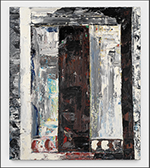
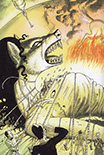
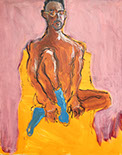
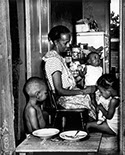
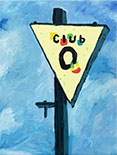

“Apocalypse Sky: Art, AIDS, and Activism in New York City, 1982–1992”
By D. Dominick Lombardi
Co-curated by Hiram Perez and Elizabeth Nogrady, “Apocalypse Sky: Art, AIDS, and Activism in New York City, 1982–1992” brings us a glimpse of what the gay and lesbian community experienced from the early days of the AIDS epidemic, most specifically in New York City. Notably, the exhibition is comprised entirely of works selected from Vassar’s Frances Lehman Loeb Art Center collection, which has holdings of over 19,000 works that go as far back as the Head of Viceroy Merymose from his Outer Sarcophagus (1375 BCE) to the recent acquisitions from such contemporary luminaries as Martin Puryear.
With “Apocalypse Sky,” the specific works selected focus on the AIDS crisis, especially the mindboggling lack of recognition and support from the Ronald Reagan administration in the first three years of the epidemic. It’s hard to believe, looking back at President Regan’s behavior, that he would not utter the word AIDS until September of 1985, a delay that surely increased the severity of the crisis, a fact that is well documented in this exhibition with the video Be a DIVA!. Be a DIVA! was produced by the Damned Interfering Video Activists Television (DIVA TV), a group of independent artists associated with ACT UP. One main purpose of the video was to document the very troubling lack of urgency, as our government minimized early concerns for the epidemic, referring to it as “gay cancer.” In Be a DIVA!, there can be seen such things as the protests at New York’s City Hall, demonstrations on how to be safe during sex, plus other issues centered on the best ways to display civil disobedience while preparing those individuals for the resulting blowback from police and other groups prompted by fear from lack of information.
In a display case nearby is a grouping of items collectively titled Assorted Ephemera (1980s–90s). Gathered here is a good sampling of what was produced by artists and activists to raise awareness, including an image of Nancy and President Reagan laughing as they strike a pose mimicking Grant Wood’s American Gothic (1930) under a headline that refers to jellybeans (Reagan’s favorite snack). George H. W. Bush, Reagan’s V.P. and presidential successor did do more to bring AIDS forward as a serious concern while somewhat reducing the stigma attached to it, but unfortunately, when looking at his overall efforts, he was very lacking in such things as setting aside real money for research and development in the production of life saving drugs.
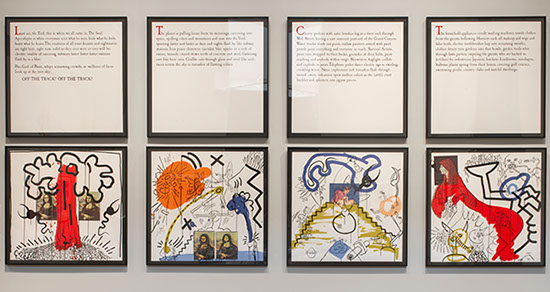
William Burroughs and Keith Haring, The Apocalypse Series (1988). Screenprint mounted on two-ply museum board; printed by Rupert Jasen Smith Inc., New York, published by George Mulder Fine Arts, New York, Installation view(s) of “Apocalypse Sky: Art, AIDS, and Activism in New York City, 1982–1992,” a 2023 exhibition at the Frances Lehman Loeb Art Center. Photo credit: On Location Studios.
Dominating the gallery space is a collaboration between the iconic artist Keith Haring and the formidable, Beat Generation author William Burroughs. The Apocalypse Series (1988), which is composed of four pairs of texts and images, projects a dizzying apocalyptic view of their time. In one, the words of Burroughs begin the top row of the installation:
“Last act, the End, this is where we all came in. The final Apocalypse is when everyman sees what he sees, feels what he feels, hears what he hears. The creatures of all your dreams and nightmares are right here, right now, solid as they ever were or ever will be, electric vitality of careening subways faster faster stations flash in a blur. Pan God of Panic, whips screaming crowds, as millions of faces look up at the torn Sky: OFF THE TRACK! OFF THE TRACK!”.
Below it is Haring’s imagery; a red phallis splitting twin Mona Lisa reproductions sporting dead, exed-out eyes and culminating in an atomic explosion as deadly, horned sperm fan out to either side. The two together, Burroughs and Haring, create a vision that hits hard at a state of anger, exhaustion and desperation with no end in sight, implying if AIDS takes over the world, there is no need for history, art or beauty. It’s all over.
Billy Name, who was a collaborator with Andy Warhol at the time Warhol was shot by Valerie Solanas in 1968, has one photograph in the exhibition, Palladium, Backstage, NYC (1992). I was lucky enough to have met and known Name before he passed in 2016, and it is important to note how great a chronicler of the time of AIDS he was, capturing the vibrancy and vitality of the time, as well as the tragedy. In Palladium, Backstage, Name shoots from the hip, capturing a moment in a performer’s life where arresting thoughts override reality and time truly freezes.
There is an excellent image of Warhol by Ari Marcopoulis, the Dutch born photographer, who was also a collaborator with Warhol. In Andy Warhol (1981), Marcopoulis captures his subject in full makeup and wig holding a recorder and blankly staring into space. What looks like a bedsheet covers most of Warhol’s body, making the image all that more striking, even strangely angelic.
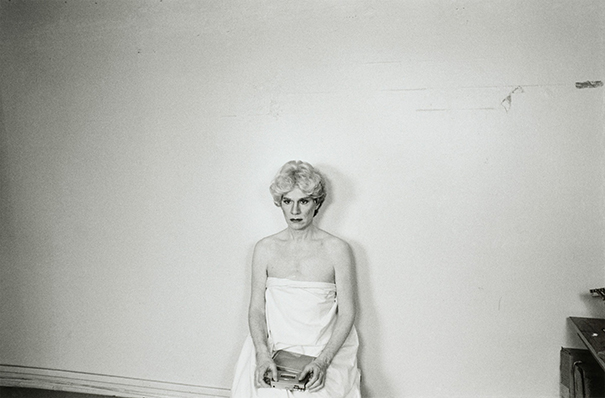
Ari Marcopoulis, Andy Warhol (1981). Silver gelatin print. Photo: https://grupaok.tumblr.com/post/189939582214/ari-marcopoulos-andy-warhol-1981-2008.
There are other intriguing photographs by Duane Michals, Robert Mapplethorpe and Nan Goldin, but what really holds this representation of an era are the various posters that dot the walls. One of the more ubiquitous images was created by Gran Fury, a group of activists who built a very effective ad campaign that appeared on numerous New York City buses. The 12- x 3-foot poster with the headline KISSING DOESN'T KILL: GREED AND INDIFFERENCE DO not only increased awareness of the AIDS crisis, it also pointed out how, as stated on the poster, that "Corporate Greed, Government Inaction and Public Indifference Make AIDS a Political Crisis." The smart design of the poster, which at first looked like a current day fashion ad, caught the eye of everyone.
The main poster that really hit me in the gut at the time was SILENCE = DEATH. The subtext on the poster addressed the lack of response from the Centers for Disease Control, the Food and Drug Administration and the Vatican, asking “Gays and lesbians” to “turn anger, fear and grief into action.”
The response to COVID, which was equally troubling at the beginning of the pandemic, should give many an idea of how scary the AIDS epidemic was just 40 years ago. The lack of leadership, complicated by the ridiculous politicization of science and procedure made the delays a little different between COVID and the AIDS crisis, but the devastation, and the unnecessary loss of life created by the delays is something that should make all the decision makers and leaders take a step back and learn from their mistakes. But as we all know, history tends to repeat and there is no other reason to think otherwise since we are now no less greedy, politically unhinged or manipulative.
D. Dominick Lombardi is a visual artist, art writer, and curator. A 45-year retrospective of his art recently traveled to galleries at Murray State University, Kentucky in 2019; to University of Colorado, Colorado Springs in 2021; and the State University of New York at Cortland in 2022.
Be a DIVA! (1990), Run time 28:00 minutes, Deep Dish TV Network, Damned Interfering Video Activists Television (DIVA TV) and Act Up. Photo courtesy of the author.
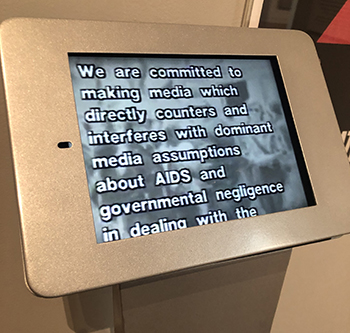

Billy Name, Palladium, Backstage, NYC (1992), gelatin silver print. Photo courtesy of the author.
(Below) Gran Fury, various posters.Photo courtesy of the author.
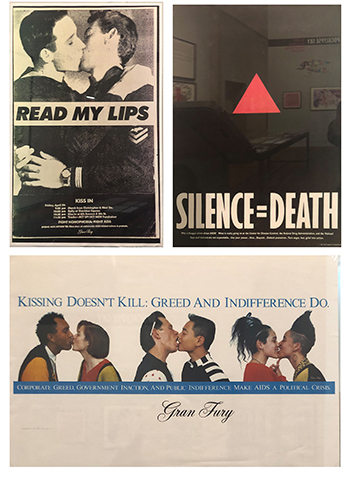
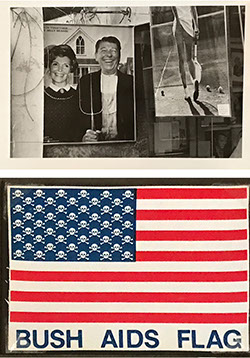
Assorted Ephemera (1980s–90s), (top) Louis Clyde Stoumen, Poster Shop, Times Square (1985). Gelatin silver print. (bottom) Bush Aids Flag, Political Sticker (1989-93). Photos courtesy of the author.